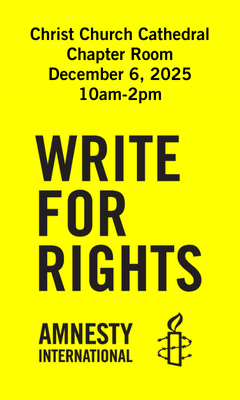Book Review: Solutions for a Wounded Planet by Jim Kingham. FriesenPress Editions, 2022.
Sept. 1 to Oct. 4 is the Season of Creation, so Jim Kingham’s book Solutions for a Wounded Planet felt like a timely read. Kingham is a parishioner at Holy Trinity, North Saanich, and he has a wealth of experience in environmental management, having been the Canadian chairman of the Great Lakes Water Quality Board, director general for all of Environment Canada’s programs in Ontario and vice-chairman of the Ontario Environmental Assessment Board. In his book, Kingham shares his knowledge and experience and offers solutions anyone concerned about environmental disasters and climate change can put into action.
The book is split into three parts. Part I provides an overview of the impact humans have had on our environmental commons: the air, water, land and species we all depend on for our survival. While some of this information will be familiar to readers — I hope it’s fairly common knowledge at this point that we are heating our planet by emitting greenhouse gases — it provides a useful context for the rest of the book.
One area of environmental degradation that I hadn’t previously considered as being on a par with climate change, but that Kingham includes, is light and noise pollution. But consider that 25 million migratory birds die in Canada each year from fatal collisions with buildings, often because they are unnecessarily lit up at night. If we view other species as important to our survival, then it suddenly becomes a more pressing issue.
Part II examines various human activities necessary to our own survival — food, shelter, security, health, energy, transportation, consumer goods, and recreation — and looks at how these areas of human activity have changed over time from being relatively sustainable to being “wasteful by design.” For example, humans once directly harnessed the power of water and wind using mills to achieve efficiency in tasks like food production. Kingham poses the question: what might wind and water power look like now if we had continued to develop these technologies, instead of going down the path of extracting and burning fossil fuels?
One area that Kingham addresses in this section and that is a personal bugbear of mine is consumer goods, or, as Kingham notes, items that were once referred to as “durables… because, well, they were durable — they lasted.” Now, however, “they are called consumer goods. They are consumed, they break down, they cannot be easily repaired, they quickly wear out and then are discarded.” Not only are products now designed with “planned obsolescence” or a short shelf life in mind, but new products and trends are continually being released to lure people into spending money on items they don’t really need. (I warned you this was a bugbear of mine.)
I’m not someone who cares about having the latest model of anything, but I still find it frustrating that it is often more expensive and time consuming to repair an item than it is to buy another one new. I remember (ten years ago) spending $45 to have the zip on a pair of trousers repaired. The tailor advised me to just get a new pair, but I gritted my teeth and handed over the money because I couldn’t bear to throw away an otherwise perfectly good pair of trousers.
Then there are the items that simply can’t be repaired. Since getting my first smart phone in 2012, I’ve gone through three smart phones and I’m on to my fourth. One by one they simply died, they just… stopped working. They now sit languishing in the back of a cupboard. While a new phone every two and a half years may seem good by some standards, I can’t help but think surely “they” could make a phone that lasts, say, five years? After all, phones and other electronics are made using raw materials that are mined from the earth, sometimes in places where there are limited environmental safeguards in place.
There have been positive steps to address this issue. This year, the EU has started the process of establishing a “right to repair” that would guarantee consumers the right to repair goods they buy. Let’s hope Canada catches up. Kingham’s proposed solution is even simpler: don’t consume so many things. One way that I’ve personally been trying to consume less this year is by taking part in the Nothing New 2022 challenge. It’s been amazing to discover how much you can buy used and how often things I think I need, I end up being able to do without.
Part III of Solutions for a Wounded Planet then delivers what it says on the tin: solutions for healing our wounded planet. The solutions Kingham puts forward range from the personal level to the community level, and from the municipal level through the regional and provincial levels, all the way up to the national and international levels.
On a personal level, Kingham offers three steps to follow: (1) Don’t despair; (2) Think about the environment in everything you do; and (3) Act. It’s easy to feel a sense of despair when reading about the way in which our global commons has been mismanaged and degraded. It’s easy, too, to think that any action we take will be meaningless in the face of far-flung big polluters. But Kingham reassures readers that any and every action they take is meaningful. After all, personal actions are the ones we have the most control over.
Some readers may find some of Kingham’s suggestions challenging to digest. For example, throughout the book Kingham emphasizes that he thinks reducing the global population is an important step towards healing our planet. While I can see that a smaller global population would equal less pressure on the planet’s resources, I can’t help but think that pursuing a smaller global population could lead down some troubling roads. We can see this in China where the one-child policy and a cultural preference for sons led to an increase in abortions of female fetuses; an increase in female babies being killed, abandoned or placed in orphanages; and a population now heavily skewed towards males.
Kingham doesn’t propose a one-child policy but instead believes the emphasis should be on educating and empowering girls and women. Again, I am absolutely for educating and empowering girls and women. Yet I can’t help but feel that this places the onus on segments of the global population who are already marginalized and are not responsible for the bulk of environmental degradation, since population growth is highest in poorer countries.
As Kingham goes through each level at which solutions can be implemented, he emphasizes that though there is less and less that the individual can do, there are still ways to effect change. For example, at the community level we can share resources. Even at the international level, individuals and communities still have a role to play by putting pressure on national governments to act together with other nations.
All in all, Solutions for a Wounded Planet left me feeling inspired to act, something that is all too rare when scrolling through gloomy newsfeeds. And more importantly, it left me brainstorming ways that I could take action. For example, by swapping smaller car journeys for journeys by bike or foot, by recommitting to not buying anything new (I’ve had a few minor lapses), and by writing to my representatives to express support for environmental initiatives. It’s too easy to feel despair or helplessness, but as Kingham writes, “Whether you are aware of it or not, millions around the world… are on your side with this battle.” So, let’s not despair; let’s act together!




